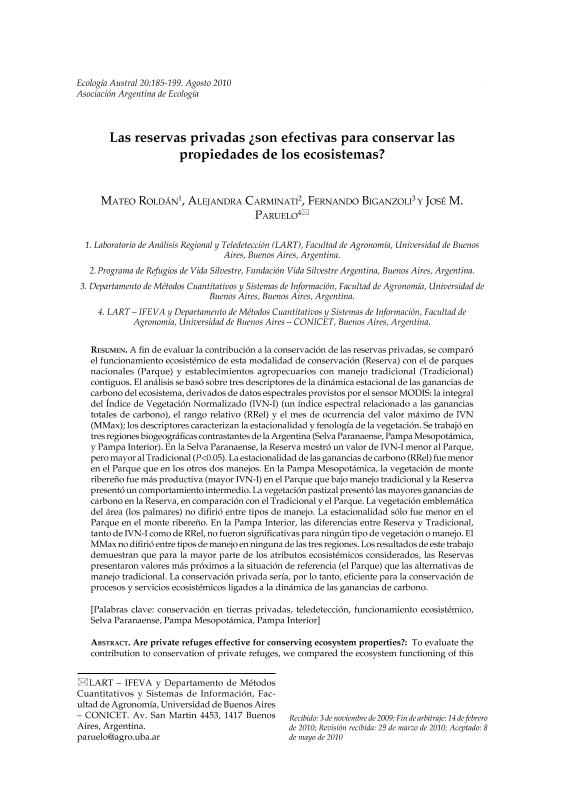Mostrar el registro sencillo del ítem
dc.contributor.author
Roldán, Mateo
dc.contributor.author
Caminati, Alejandra
dc.contributor.author
Biganzoli, Fernando

dc.contributor.author
Paruelo, José

dc.date.available
2020-02-14T20:40:38Z
dc.date.issued
2010-08
dc.identifier.citation
Roldán, Mateo; Caminati, Alejandra; Biganzoli, Fernando; Paruelo, José; Las reservas privadas ¿son efectivas para conservar las propiedades de los ecosistemas?; Asociación Argentina de Ecología; Ecología Austral; 20; 2; 8-2010; 185-199
dc.identifier.issn
1667-782X
dc.identifier.uri
http://hdl.handle.net/11336/97669
dc.description.abstract
A fin de evaluar la contribución a la conservación de las reservas privadas, se comparó el funcionamiento ecosistémico de esta modalidad de conservación (Reserva) con el de parques nacionales (Parque) y establecimientos agropecuarios con manejo tradicional (Tradicional) contiguos. El análisis se basó sobre tres descriptores de la dinámica estacional de las ganancias de carbono del ecosistema, derivados de datos espectrales provistos por el sensor MODIS: la integral del Índice de Vegetación Normalizado (IVN-I) (un índice espectral relacionado a las ganancias totales de carbono), el rango relativo (RRel) y el mes de ocurrencia del valor máximo de IVN (MMax); los descriptores caracterizan la estacionalidad y fenología de la vegetación. Se trabajó en tres regiones biogeográficas contrastantes de la Argentina (Selva Paranaense, Pampa Mesopotámica, y Pampa Interior). En la Selva Paranaense, la Reserva mostró un valor de IVN-I menor al Parque, pero mayor al Tradicional (P<0.05). La estacionalidad de las ganancias de carbono (RRel) fue menor en el Parque que en los otros dos manejos. En la Pampa Mesopotámica, la vegetación de monte ribereño fue más productiva (mayor IVN-I) en el Parque que bajo manejo tradicional y la Reserva presentó un comportamiento intermedio. La vegetación pastizal presentó las mayores ganancias de carbono en la Reserva, en comparación con el Tradicional y el Parque. La vegetación emblemática del área (los palmares) no difirió entre tipos de manejo. La estacionalidad sólo fue menor en el Parque en el monte ribereño. En la Pampa Interior, las diferencias entre Reserva y Tradicional, tanto de IVN-I como de RRel, no fueron significativas para ningún tipo de vegetación o manejo. El MMax no difirió entre tipos de manejo en ninguna de las tres regiones. Los resultados de este trabajo demuestran que para la mayor parte de los atributos ecosistémicos considerados, las Reservas presentaron valores más próximos a la situación de referencia (el Parque) que las alternativas de manejo tradicional. La conservación privada sería, por lo tanto, eficiente para la conservación de procesos y servicios ecosistémicos ligados a la dinámica de las ganancias de carbono.
dc.description.abstract
To evaluate the contribution to conservation of private refuges, we compared the ecosystem functioning of this type of conservation (Refuge) with contiguous national parks (Park) and rural ranches and farms under traditional management (Traditional). We assume the Park as the reference situation, in as much they constitute the areas with the lowest human intervention. The analysis was based on three descriptors of the seasonal dynamics of the carbon gains, derived from spectral data provided by the MODIS sensor: the Normalized Difference Vegetation Index integral (NDVI-I), a spectral index related to the total carbon gains of the ecosystem; the relative range [RRel: (maximum NDVI–minimum NDVI)/(NDVI-I)], and the month of occurrence of the maximum value of NDVI (MMax). These last two attributes characterize the seasonality and phenology of vegetation. We worked on three contrasting biogeographic regions of Argentina [Paranaense forest (Misiones province), Mesopotamic Pampa (Entre Ríos province), Interior Pampa (Córdoba province)]. In the Paranaense forest, the Refuge presented a lower NDVI-I value than the Park, but higher than the Traditional (P<0.05). The seasonality of the vegetation carbon gains (RRel) was lower on the Park than for the other two managements. In the Mesopotamic Pampa, the gallery forests were the most productive unit (higher NDVI-I). The Refuge presented an intermediate behavior. Grasslands presented the highest NDVI-I on the Refuge (P<0.05). The emblematic vegetation of this region (the palm savannas), did not differ among managements. The seasonality was lower in the gallery forests of the Park. In the Interior Pampa, the differences between Refuge and Traditional, both in NDVI-I and RRel, were not significantly different among vegetation types or managements. The MMax did not differ between managements for any of the regions studied. Our results showed that for most of the ecosystem attributes considered, the Refuge presented values more similar to those of the reference situation (the Park) than to the traditional management alternatives. Private conservation therefore has being efficient for the conservation and maintenance of the ecosystemic processes and services bounded to the dynamic of the vegetation carbon gains.
dc.format
application/pdf
dc.language.iso
spa
dc.publisher
Asociación Argentina de Ecología

dc.rights
info:eu-repo/semantics/openAccess
dc.rights.uri
https://creativecommons.org/licenses/by-nc-sa/2.5/ar/
dc.subject
Conservación en Tierras Privadas
dc.subject
Teledetección
dc.subject
Funcionamiento Ecosistémico
dc.subject
Selva Paranaense
dc.subject.classification
Otras Ciencias Agrícolas

dc.subject.classification
Otras Ciencias Agrícolas

dc.subject.classification
CIENCIAS AGRÍCOLAS

dc.title
Las reservas privadas ¿son efectivas para conservar las propiedades de los ecosistemas?
dc.title
Are private refuges effective for conserving ecosystem properties?
dc.type
info:eu-repo/semantics/article
dc.type
info:ar-repo/semantics/artículo
dc.type
info:eu-repo/semantics/publishedVersion
dc.date.updated
2019-03-08T20:19:52Z
dc.identifier.eissn
0327-5477
dc.journal.volume
20
dc.journal.number
2
dc.journal.pagination
185-199
dc.journal.pais
Argentina

dc.description.fil
Fil: Roldán, Mateo. Universidad de Buenos Aires. Facultad de Agronomía; Argentina
dc.description.fil
Fil: Caminati, Alejandra. Fundación Vida Silvestre; Argentina
dc.description.fil
Fil: Biganzoli, Fernando. Consejo Nacional de Investigaciones Científicas y Técnicas; Argentina. Universidad de Buenos Aires. Facultad de Agronomía. Departamento de Métodos Cuantitativos y Sistemas de Información; Argentina
dc.description.fil
Fil: Paruelo, José. Consejo Nacional de Investigaciones Científicas y Técnicas. Oficina de Coordinación Administrativa Parque Centenario. Instituto de Investigaciones Fisiológicas y Ecológicas Vinculadas a la Agricultura. Universidad de Buenos Aires. Facultad de Agronomía. Instituto de Investigaciones Fisiológicas y Ecológicas Vinculadas a la Agricultura; Argentina
dc.journal.title
Ecología Austral

dc.relation.alternativeid
info:eu-repo/semantics/altIdentifier/url/http://ojs.ecologiaaustral.com.ar/index.php/Ecologia_Austral/article/view/331/134
Archivos asociados
